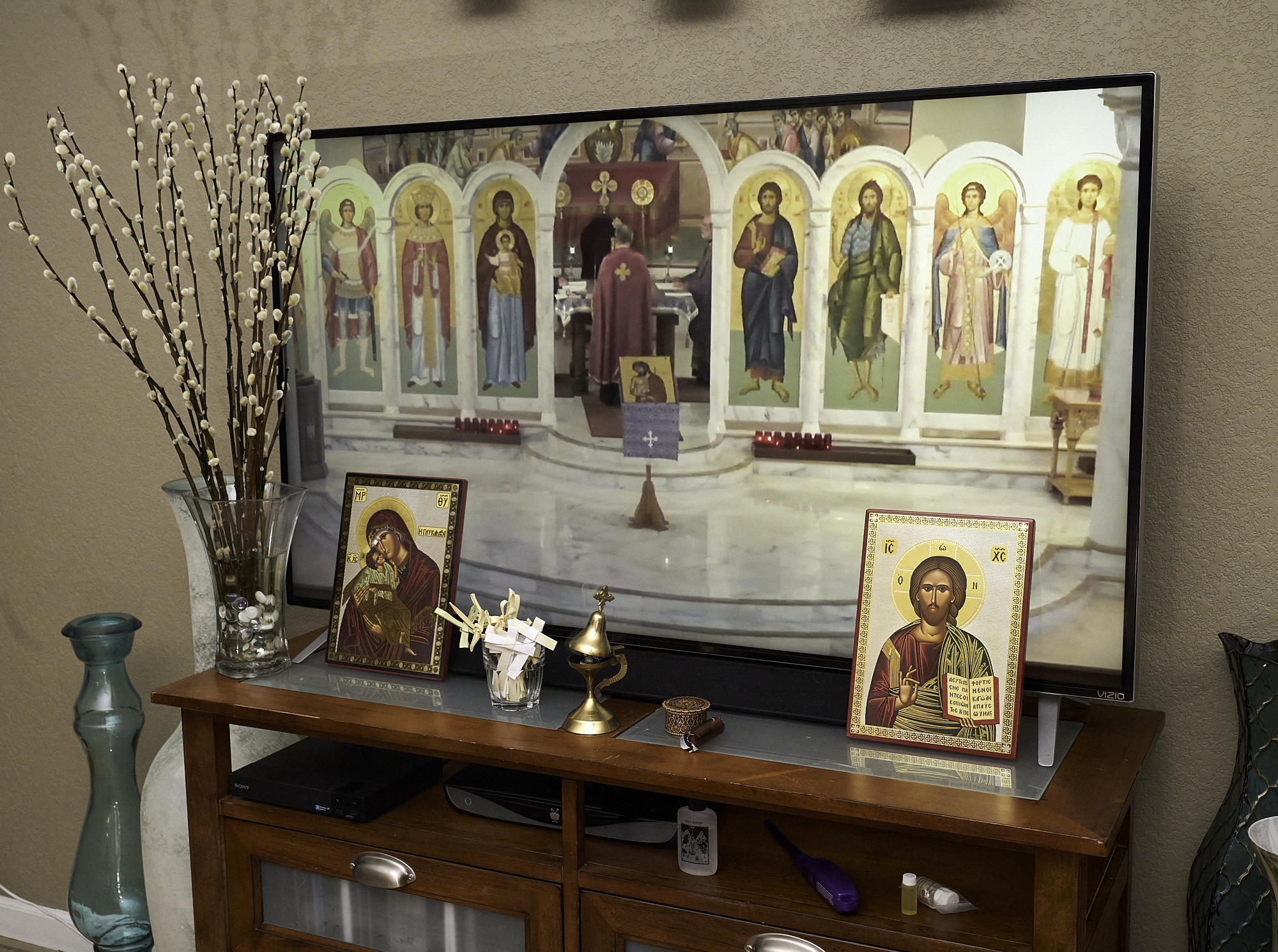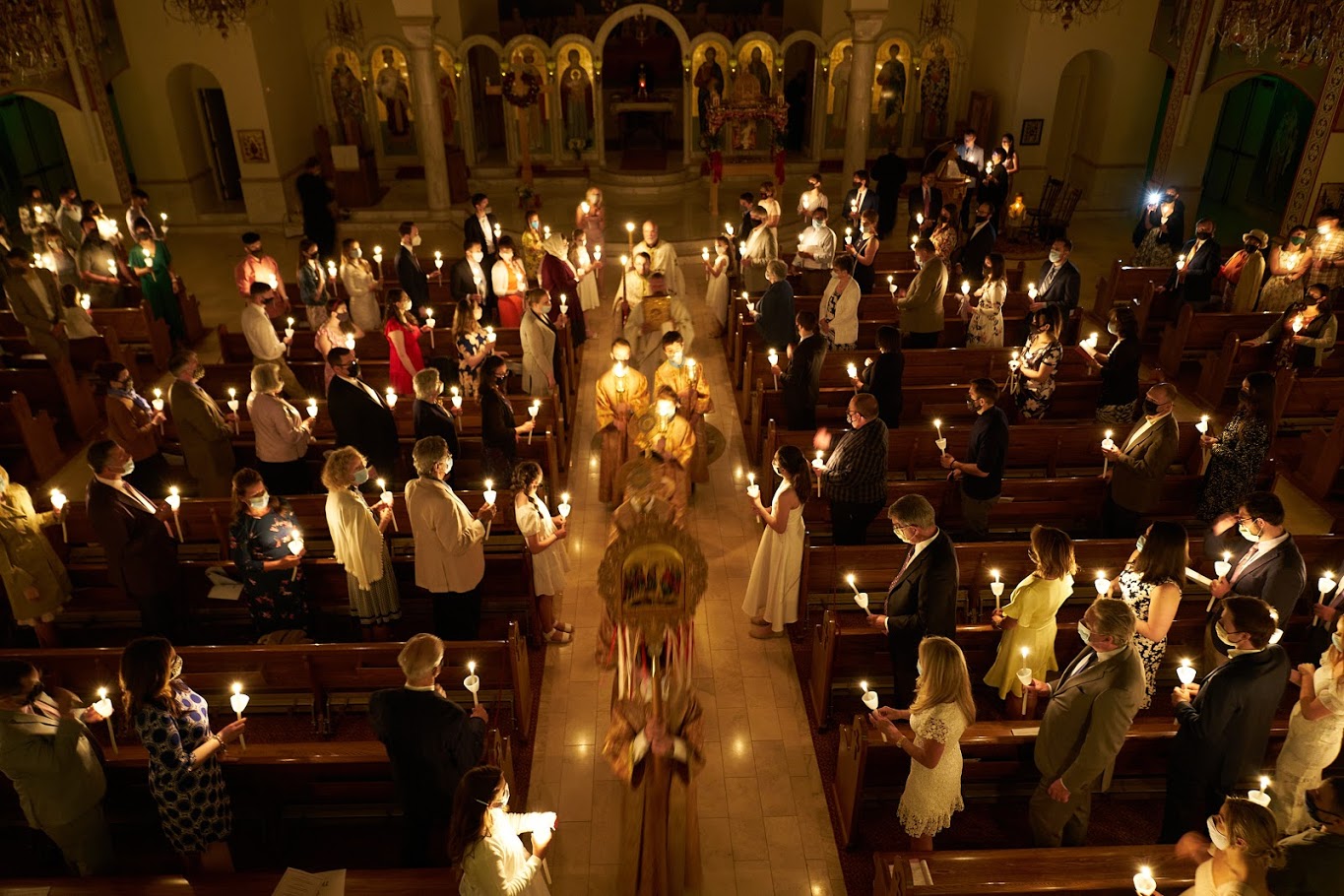For an entire year my Colorado parish had been hosting two Divine Liturgies on Sundays in order to accommodate as many socially distanced parishioners as possible. But the statewide mask mandate was lifted a few weeks ago, and many businesses no longer require masks for those who are fully vaccinated. Social distancing is recommended but not required.

We immediately returned to one service: the body of Christ once again united in worship, the exhausted clergy, staff, and Parish Council members gladly relinquishing the extra duties that Covid-19 has required. Around here, daily life is starting to approach the normalcy of 2019, when pandemic was a seldom-used vocabulary word and few people had heard of a coronavirus.
If the churches in your state are still operating under tighter restrictions, I really feel for you. This has been a long 15 months. (I’m looking at you, Orthodox Californians.)
The sense of joy in gathering together again is palpable. And the return to almost-normal reminds me of the physicality of Orthodox worship and how much we’ve missed.
Online Orthodoxy Doesn’t Work
Modern Christianity, especially the Protestant realm in the Anabaptist tradition, tends to be about what goes on in the head and the heart—what we know and feel. Faith is largely separated from the physical world, and, frankly, from anything that looks or smells Roman Catholic. Many of these churches have actually eliminated the cross from the worship space. Walls are bare—so bare that a stranger could mistake the church interior for a theater or auditorium.
Orthodoxy Christian practice is the opposite of this bare-bones philosophy, and the realities of pandemic lockdowns have been a potent reminder of the the visceral nature of our worship practices.
Last year as the coronavirus surged and governments around the world forced various levels of lockdowns, worship went online for everyone, not just shut-ins. Actually, we all became shut-ins.

And as my family cast our parish’s YouTube channel to our TV screen, I suddenly realized that for many Protestants, the online experience is not vastly different from an in-person service. Of course, the lack of personal interaction is painful for everyone, but in many Evangelical churches the worship service has devolved into little more than a concert and a lecture. It is largely a spectator experience, and in some churches, the music is blasted at such a loud volume it’s hard to tell if any of the congregants are singing along with the band.
But beyond the isolation of TV services, there are three interrelated reasons why online worship is not the future of Orthodoxy.
1. We Are Embodied
Orthodox Christianity understands the importance of our bodies. Our worship is participatory. In corporate prayer we stand, bow, cross ourselves, kneel, and perform prostrations during Great Lent. Our Wednesday/Friday fasts and longer fasting seasons are of course intimately connected with what we do and do not put into our bodies, and all of the sacraments, including baptism and holy unction, are received through the body.
The position of our bodies affects our minds and spirits. Sitting and watching a service, even attentively, is not conducive to worship.
As Fr. Lawrence Farley wrote in Let Us Attend: A Journey through the Orthodox Divine Liturgy (Conciliar Press [now Ancient Faith Publishing], 2007):
Some might think that posture does not matter, and that as long as a person pays attention in the heart, the bodily position is irrelevant. . . . Since we are a compound of spirit and matter, what our bodies do also affects our spirits. That is why the church bids us to make prostrations during Great Lent, for the humbling of the body helps to humble the spirit. In the same way, standing up straight and tall helps us attend to the presence of Christ in our midst. By standing upright, “at attention,” we heighten our attitude of expectancy as we enter the presence of God. (p. 29)
This physical approach to the spiritual life is not an innovation that evolved over the centuries but is evident in ancient Jewish practices. Father Stephen Freeman noted a few years ago in his blog Glory to God for All Things (May 7, 2019):

When God gave commandments to Israel and told them to bind them to their arms and keep them before their eyes, He did not mean that they should merely keep them uppermost in their thoughts. They literally bound them on their arms and wore them on their foreheads. They set them in their doorposts. These were salutary practices—not superstitions. They are the practices of a people who understand that they were created as embodied people and not as abstractions.
Of course, we can use our bodies and incorporate physical elements while watching our a service on our screens. When Colorado was under stay-at-home orders in the spring of 2020, I tried to do everything possible to prevent Holy Week from becoming a spectator experience. I did prostrations on the corner of the area rug, trying to ignore the dog fur and potato chip crumbs. I lit candles and stood during the Gospel readings. The physical practices helped, but the flatness of the virtual experience was still alienating.
2. God Gave Us Five Senses
Online services, and many modern in-person church services, concentrate on the senses of sight and hearing, with occasional bodily movement in standing, sitting, and, if permitted, the raising of hands and even dancing. The other senses are largely ignored. But limiting the use of all of the senses can result in limiting the ways we can learn and incorporate spiritual truths into our lives.
Last year, in the midst of the pandemic summer, I wrote in a blog post,
The ancient worship of the Orthodox Church is an active, physical practice. All of the senses are involved—the fragrance of incense, the visual feast of iconography, the sounds of chanting and the bells on the censer, the touch of anointing oil on the forehead and the kissing of icons, and, at the center of our worship, the taste of the bread and wine of Holy Communion.
Watching a service online doesn’t compare. Even though we’re grateful for the technology that keeps us connected, a Divine Liturgy on a computer monitor is an exercise in sensory deprivation. We do our best in the vacuum as we stand in front of our screens, cross ourselves, and sing along with “Lord have mercy.” Some of us burn incense in our home censers to add a bit of holy fragrance to our messy living rooms. But our efforts still feel impoverished.

The physicality of Orthodox worship is more than a matter of style, a question of high-church versus low-church practices. All of our physical practices are an outworking of the meaning of the Incarnation. Christ truly came in the flesh, and He doesn’t save our souls only. His grace fills all aspects of our lives, and He transforms His people into His image, deifying them. We honor this reality with icons of the saints. We use candles, incense, and holy water in our worship.
But the primary reason that online worship will never be the future of Orthodox Christianity is not simply the absence of the gathered community. It is the reality that this particular gathered community is a eucharistic community. This leads to #3:
3. The Eucharist Can Never Be Virtual
The central part of the Divine Liturgy, our primary reason for gathering, is the Holy Eucharist, and it cannot be replicated on a screen.
As Fr. Theodore Dorrance explained in a 2019 blog post,
The local church is a eucharistic community, meaning that the center of its life is the exercise of the members’ royal priesthood (1 Pet. 2:9) in the offering of their lives and all God’s creation back to Him in thanksgiving. . . . The priest offers the bread and wine back to God on behalf of the local membership of believers. God, in turn, receives this thanksgiving offering and consecrates the gifts by His Holy Spirit, changing the bread and wine into His Body and Blood (Mk. 14:22-24). The members then receive back from God His Body and His Blood, experiencing an intimate and transformative union with God (John 6:56).
We can contribute some “smells and bells,” so to speak, to our home Internet viewing. We can all incorporate incense, candles, icons, holy water, and anointing oil into our lives.

But there is no do-it-yourself Eucharist.
In the Orthodox Church, the Eucharist is not merely a memorial supper. Crackers and grape juice at home are no substitute. Unlike the Quakers, we can never eliminate the Eucharist, and other sacraments, by adopting the belief that everything is equally sacramental and thus the physical is not necessary. We do not add communion to the schedule on a monthly, bimonthly, or quarterly basis. The Eucharist has always been, and always will be, the center of our worship.
If I am ill or otherwise housebound, a member of the clergy can bring communion to me. But I cannot create it myself.
The Eucharist is an irreplaceable part of the life of the Church. Saint Porphyrios wrote,
We need to live the mysteries, especially the mystery of Holy Communion. It’s in these that Orthodoxy is found. Christ is offered to the Church through the mysteries and primarily through Holy Communion.
When we all became shut-ins last year, my parish purchased a camera with better resolution for the online streaming that had suddenly become vital. This year, as we gathered in a limited way with only a fraction of households able to attend in person, we found ways to use close-ups and more than one camera for Holy Week services.
We made the best of a difficult situation, but a camera can never provide the full sensory experience of worship or, most importantly, the Body and Blood of our Lord Jesus Christ. We need to be present, together, participating in a Divine Liturgy that is never a virtual, spectator experience. It is truly “the work of the people.”

As Fr. Stephen wrote,
God became flesh and was held on the Cross by His body. We continue to eat and drink His Body and Blood. It is with all that in mind that I have said any number of times, “Ninety percent of Orthodoxy is just showing up.” There are important things that happen when we show up, but nothing can happen until we do.
May your return to the physical Divine Liturgy, now or, by God’s grace, in the near future, find its place again as the precious center of your spiritual life. May we never take the physical reality of worship for granted.
Beautiful and True! Thank you for this. I have bookmarked it and shared it already. Glory to God!
Thank you. Glory to God for all things!
Thank-You.
You’re welcome!